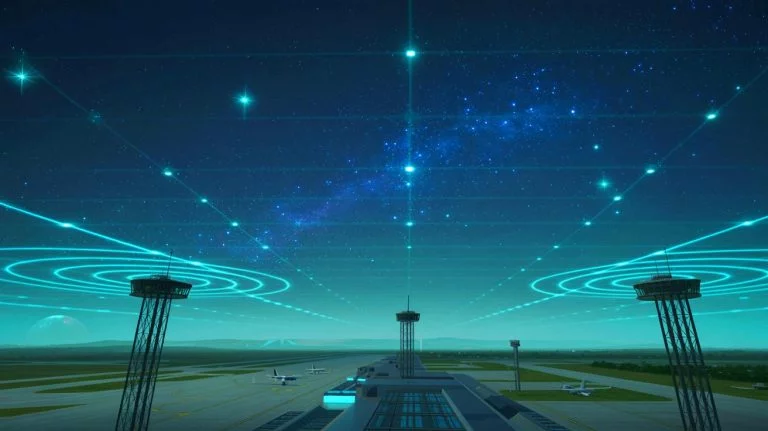| IN A NUTSHELL |
|
As we continue to advance technologically, the implications of our progress ripple across the cosmos in ways we are only beginning to understand. Recent research suggests that our planet’s radar systems, integral to both civilian and military operations, may be unwittingly broadcasting our presence to distant stars. These signals, while crucial for monitoring aircraft and maintaining national security, could act as beacons to technologically advanced alien civilizations. The potential for Earth to be detected by extraterrestrial observers raises profound questions about our place in the universe and the unintended messages we might be sending to the stars.
Radar Signals: Unintentional Beacons in the Cosmos
Radar systems at major international airports and military facilities generate substantial electromagnetic emissions, acting as unintentional markers of intelligent life. According to new findings presented at the Royal Astronomical Society’s National Astronomy Meeting 2025, these emissions could be detected up to 200 light-years away by observers with advanced radio telescopes. The study highlights that airports such as Heathrow, Gatwick, and JFK emit detectable signals, which may inadvertently reveal Earth’s presence to alien civilizations.
These signals, primarily used for aircraft monitoring, have a combined radio output of 2×10¹⁵ watts. This output is significant enough to be picked up by radio telescopes akin to the Green Bank Telescope in West Virginia. To put this into perspective, the closest potentially habitable exoplanet, Proxima Centauri b, lies just 4 light-years away. However, reaching it with current spacecraft technology would take thousands of years. Nevertheless, the presence of such signals in our cosmic neighborhood underscores the potential for interstellar detection.
Jaya Anand Singh’s Research Path : A Journey from Curiosity to Contribution
Military Radars: Powerful and Potentially Revealing
While civilian radar systems are already substantial, military radars present an even more pronounced signature. These systems, characterized by their focused and directional emissions, create a unique pattern that resembles a lighthouse beam sweeping the sky. The peak emission of military radars reaches about 1×10¹⁴ watts within an observer’s field-of-view, making them highly detectable.
Ramiro Caisse Saide, the study’s lead researcher from the University of Manchester, notes that such emissions would appear “clearly artificial” to alien observers equipped with powerful telescopes. Depending on their location in space, these military signals could appear up to a hundred times stronger than civilian ones. This increased detectability raises concerns about how our technological advancements might be perceived by extraterrestrial civilizations.
Technosignatures and the Search for Extraterrestrial Intelligence (SETI)
The research on radar emissions contributes significantly to the understanding of technosignatures, which are indicators of advanced technological civilizations. According to the findings, any planet with sophisticated radar technology might inadvertently signal its existence to the cosmos. This enhances the search for extraterrestrial intelligence (SETI) by identifying promising technosignatures.
Professor Michael Garrett, a co-researcher from the University of Manchester, emphasizes the dual significance of these findings. Not only do they aid in answering the age-old question, “Are we alone?” but they also offer insights into protecting the radio spectrum for communications. Additionally, the methodologies developed for modeling and detecting these signals serve broader applications in astronomy, planetary defense, and assessing the impact of human technology on our space environment.
The Broader Implications of Our Cosmic Footprint
Understanding how our signals traverse the universe is paramount for both scientific exploration and practical management of technology’s influence. Caisse Saide highlights that this work supports the scientific quest for extraterrestrial life while simultaneously addressing technological impacts on our world and beyond. As we continue to develop and deploy advanced radar systems, it becomes essential to consider how these technologies might affect our cosmic footprint.
These insights prompt us to reflect on the broader implications of our technological advancements. How do we balance progress with the potential risks of unintended exposure to extraterrestrial observers? What measures can we take to manage our electromagnetic emissions responsibly? These questions underscore the need for thoughtful consideration of our place in the universe and the legacy we leave in the stars.
As we peer deeper into the cosmos, the signals we send and receive carry profound implications for our understanding of the universe and our role within it. The potential for our radar systems to act as unintentional beacons invites us to ponder the vast possibilities of interstellar communication and discovery. What other messages might we be sending to the stars, and how should we prepare for the possibility of a response?
Did you like it? 4.5/5 (30)







Are we sure aliens would even understand our signals as a sign of intelligent life? 🤔
Thank you for this enlightening article! I never considered that our technology might be visible to aliens. 🌌
What can we actually do to stop broadcasting our location, if it’s accidental? 🤷♂️
This sounds like a plot from a sci-fi movie. Are we really in danger? 👽
How can we be so sure that aliens have the technology to detect us?
It’s definitely interesting to think about our radar systems as cosmic lighthouses!
Could this unintentional broadcasting have already attracted alien attention without us knowing? 😱
Thanks for raising awareness about this issue. It’s fascinating and a bit scary!
How do they know that aliens would perceive these signals as “clearly artificial”?